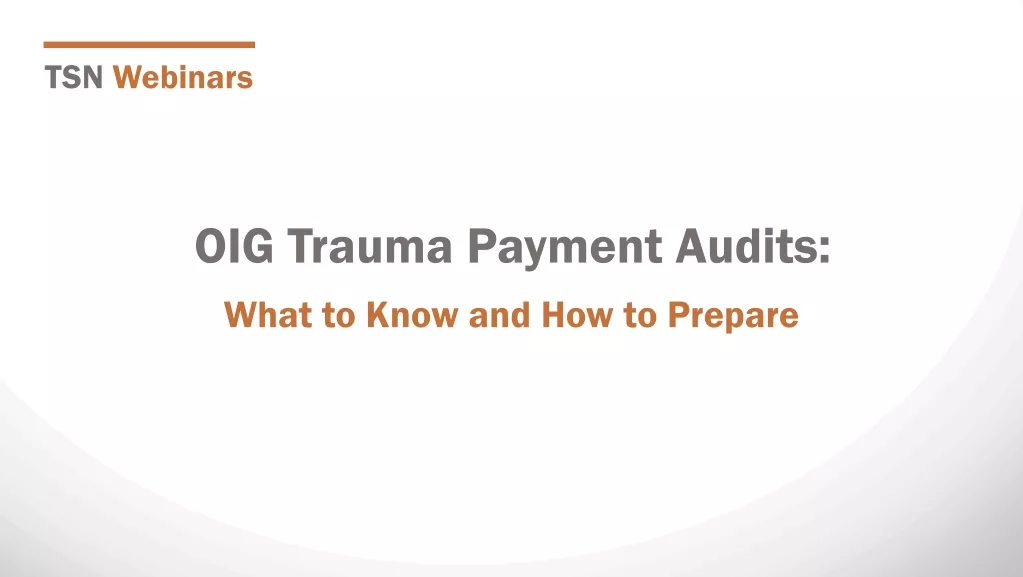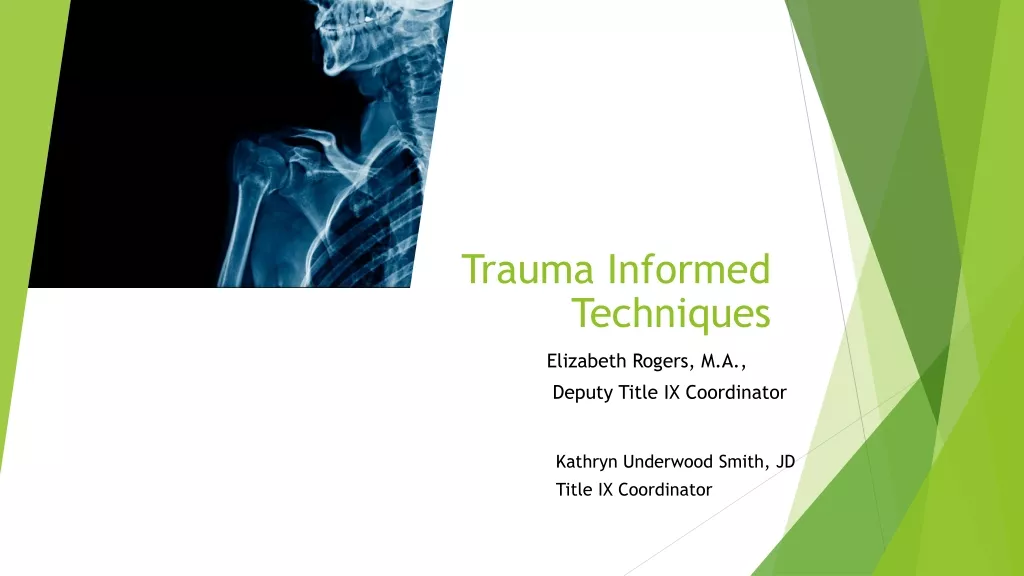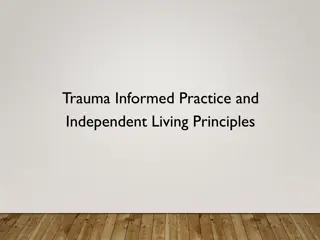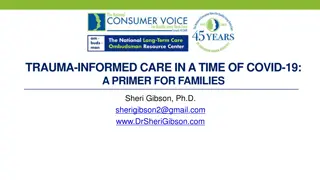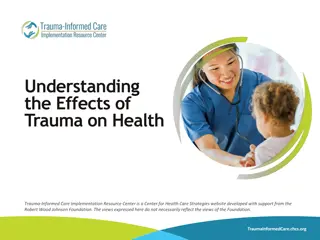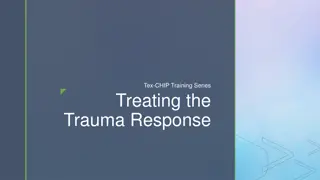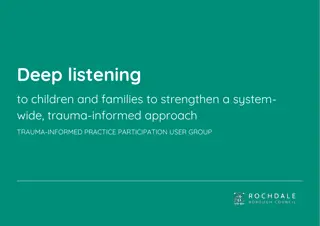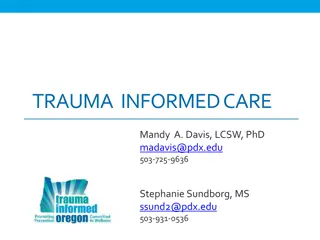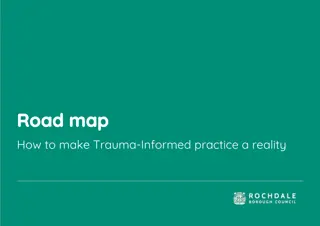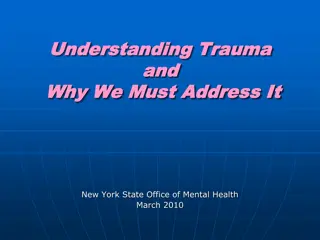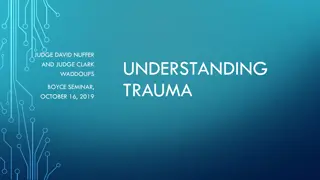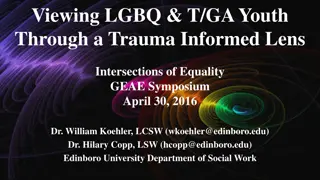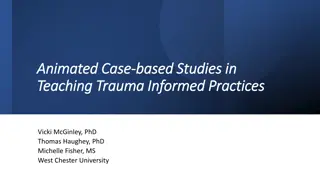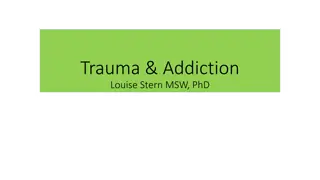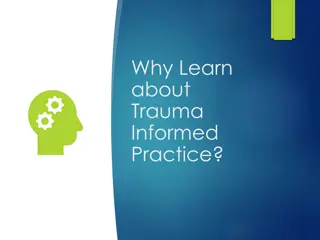Equity-Centered Trauma-Informed Education Overview
Explore the fundamentals of Equity-Centered Trauma-Informed Education (ECTIE) including the definition of trauma, examples of potentially traumatic events, and strategies for creating awareness, taking action, and advocating for equity. Learn how to implement trauma-informed practices, address systemic inequities, and support students' well-being within educational settings.
Download Presentation

Please find below an Image/Link to download the presentation.
The content on the website is provided AS IS for your information and personal use only. It may not be sold, licensed, or shared on other websites without obtaining consent from the author.If you encounter any issues during the download, it is possible that the publisher has removed the file from their server.
You are allowed to download the files provided on this website for personal or commercial use, subject to the condition that they are used lawfully. All files are the property of their respective owners.
The content on the website is provided AS IS for your information and personal use only. It may not be sold, licensed, or shared on other websites without obtaining consent from the author.
E N D
Presentation Transcript
Introduction to Equity-Centered Trauma-Informed Education
Todays Goals Review or introduce the basics of equity-centered, trauma-informed education (ECTIE) Share the common language we used with preservice teacher candidates Let you know what are candidates are bringing to their student teaching classrooms Share some stories of preservice teacher candidates experiences in the field
The Journey Instructors were trained on ECTIE. Modifications were made to 2 Elementary Education courses (SPED 405, CI 406) and EDPR 250 (field placement and seminar). Candidates had an introduction to the content you ll see today. El Ed was in person; middle and secondary candidates saw a recording. The Elementary Education candidates saw ECTIE integration during supervision (pre- post- conferences and evaluations), CI 406, SPED 405.
Definition of Trauma Trauma results from an event, series of events, or set of circumstances that is experienced by an individual as physically or emotionally harmful or threatening and that has lasting adverse effects on the individual's functioning and physical, social, emotional, or spiritual well-being (SAMHSA). Meghana Ratna Pydi
Examples of Potentially Traumatic Events Witnessing or experiencing physical, sexual, emotional abuse Neglect Family members who have mental health or substance abuse disorders Divorce Violence in the community Poverty and/or systemic discrimination (racism, ableism, sexism) Institutional trauma Developmental trauma Isolated events such as a natural disaster or auto accident Chronic bullying COVID was a traumatic event for many
Awareness, Action, and Advocacy: An Equity-Based, Trauma-Informed Framework AWARENESS ACTION ADVOCACY Realize: -The incidence of trauma -Brain-based impacts of trauma -Systemic inequities as a cause of trauma -Your role in trauma and inequity -The importance of self-care to mitigate STS Respond: -Implement equity-centered, trauma- informed practices universally -Get to know your students and their lived experiences -Intervene in inequities -Set (and equitably apply) reasonable boundaries and expectations -Solicit and value feedback from students Redress: -Advocate against inequities -Promote student advocacy efforts -Have conversations about inequities Actively Cultivate: -Apply a trauma-informed equity lens -Prioritize marginalized populations Recognize: -The symptoms of trauma, mental health challenges in adults and students -Bias and inequity in your classroom/institution -Root causes of inequity and trauma -Deficit mindsets -Instances of power and privilege Sustain -Commit to equity in the face of concern Resist Retraumatization -Avoid trauma triggers and repair damage -Universality of practice -Use curriculum, assessment, and practices that reflect student identities and experiences -Use discipline strategies that teach not punish
Equity-Centered, Trauma-Informed Practice for Teacher Educators
AWARENESS Realize: -The incidence of trauma -Brain-based impacts of trauma -Systemic inequities as a cause of trauma -Your role in trauma and inequity -The importance of self-care to mitigate STS AWARENESS: Realize Recognize: -The symptoms of trauma, mental health challenges in adults and students -Bias and inequity in your classroom/institution -Root causes of inequity and trauma -Deficit mindsets -Instances of power and privilege
Realize: The High Incidence of Trauma The numbers vary, but studies indicate more than half the students in your classroom have experienced at least one potentially traumatic event: Data from the CDC indicates 61% of adults surveyed across 25 states said they had experienced at least one adverse childhood experience by the time they were 18 years old (2019). National Survey of Children s Health (2016) found that almost half of all children in the country experienced at least one adverse childhood experience. 10% had experienced three or more. In a 2009 study, 85% of college students reported having experienced a traumatic event (Frazier et al., 2009).
Realize: Incidence Higher in Marginalized Populations The incidence of trauma is significantly higher among marginalized populations (e.g., individuals with disabilities, individuals who live in poverty, children of color, LGBTQ population, military youth, homeless youth) Social injustices, past and present (racism, sexism, poverty, ableism, identity discrimination, and other biases) are potentially traumatic. Systems/institutions (including education) can be traumatic for individuals Teachers actions, ideas, identities, biases impact their practices which may cause trauma in students
Realize the Impacts of Trauma Trauma can impact behavior, emotions and relationships, and academic performance. Brain stem is responsible for safety which trumps all other brain processes. When an individual is experiencing fear (fight/flight/freeze response), they are stuck in their brain stem, attachments cannot be formed and learning cannot occur. Responses are often not choices-they are brain-based in a response to threat or fear (fight-flight-freeze)
The HUMAN Brain The anatomy and function of the normal brain is the same for every human being, so al this information applies to US and our preservice teachers. The brain responses (neural pathways) among individuals who are chronically stressed and individuals who have experienced trauma are the same or similar-this removes the need for a trauma label - it s ALL HUMANS. Trauma-informed practices help all people, but are critical for those who have experienced trauma.
AWARENESS Realize: -The incidence of trauma -Brain-based impacts of trauma -Systemic inequities as a cause of trauma -Your role in trauma and inequity -The importance of self-care to mitigate STS AWARENESS: Recognize Recognize: -The symptoms of trauma, mental health challenges in adults and students -Bias and inequity in your classroom/institution -Root causes of inequity and trauma -Deficit mindsets -Instances of power and privilege
Recognize: The Signs and Symptoms of Trauma The signs and symptoms (manifestations) of trauma typcially exhibited in children s and adolescents fall into three categories: Behavior Emotional/Relational Academic performance
Manifestations of Trauma in Children: Behavior Externalizers Acting out behavior Ignoring/defying directions Difficulty self-regulating Hyperactivity Internalizers Shutting down ( hoodie hider ) Anxiety and depression Oversensitivity
Manifestations of Trauma in Children: Emotional/Relational Relationships/Social Emotional Expectations of danger in new and/or existing relationships Fear of being hurt Difficulty with trust Difficulty with adult and peer relationships Shame or guilt Anxiety or depression A desire to isolate or withdraw
Manifestations of Trauma in Children: Academics/Learning Decreased executive functioning Decreased cognitive skills Learning disabilities Poor memory Inability to unconsciously shift attention between multiple tasks Deficits in verbal ability (specifically comprehension and vocabulary) Challenges with mathematical calculation
Recognize Potential Causes of Trauma: The Trauma-Informed Lens Root Causes Individual traumas Biases Inequities Oppressive ideologies Classroom materials that are not representative of the varied cultures of our classroom and the world. Practices or policies that could trigger students who have experienced trauma. Punitive/exclusionary discipline policies, homework policies, dress codes Ability tracking Deficit mindsets
Trauma-Informed Practices: Paradigm Shifts What happened to this child? What s wrong with this child? The student needs attention to connect. This child is seeking attention. The child can t do this because they are stressed. The child won t do this. The student needs connection and logical consequences after misbehaving. The child needs a time out after misbehaving. I need to control and fix this child s behavior. I need to understand this child s behavior.
Examples from the Field AWARENESS
ACTION Respond: -Implement equity-centered, trauma- informed practices universally -Get to know your students and their lived experiences -Intervene in inequities -Set (and equitably apply) reasonable boundaries and expectations -Solicit and value feedback from students ACTION: Respond Resist Retraumatization -Avoid trauma triggers and repair damage -Universality of practice -Use curriculum, assessment, and practices that reflect student identities and experiences -Use discipline strategies that teach not punish
Respond: Trauma-Informed Practices The Big Three 1. Creating Safety in the Learning Environment 2. Building Relationships 3. Teaching and Practicing Self-Regulation Skills Others: Discipline that teaches rather than punishes Strengths-based approach/mindset
Respond: Creating a Safe Learning Environment Identity Safety All students are not only accepted, but are celebrated for their uniqueness Build a culture that celebrates diversity. Physical and Emotional Safety Maintain an organized classroom. Involve students in developing clear, positive expectations. TEACH and use consistent and predictable routines and procedures. Post the daily schedule. Warn students about unexpected changes to the routine. Talk through transitions. Be aware of triggers.
Respond: Creating a Safe Learning Environment Lessons that are at the appropriate level and are relevant to the lives of the students in their classrooms. Universal Design for Learning: Multiple options for how to gain the knowledge Multiple options for demonstrating their knowledge Multiple ways to engage students Intervene in any instance of inequity or bias. Boundaries should be reasonable and consistently/equitably applied.
Respond: Building Relationships with Children Strategies to build relationships: 2x10 strategy Greet students by name at the door Insist on a bully-free environment Establish and maintain a supportive classroom culture Morning meeting circles Listen to student perspectives and let them know their voices are heard. ALWAYS respond with (MODEL) empathy. Small interactions go a LONG WAY.
Respond: Teach Children Self-Regulation Help students navigate and verbally express their emotions. Self-regulation strategies to incorporate/teach before: Take regular brain-breaks (clapping, call-and-response games, silent ball, etc.) Incorporate movement, mindfulness and meditation Go Noodle, Move to Learn, muscle relaxation, deep breathing, listening to classroom sounds, visualization). Provide time for movement (rhythmic) Peace corners, calming corners, designated adult Stress balls, fidget spinners, Flexible seating (wiggle seats, standing desks, individual spaces) Teach them about their bodies and their brains.
Model Self-Regulation Adults model thinking : I am really angry right now and I need a minute to breathe.. Please take out a book or sit quietly I m going to just take a few deep breaths Let s all get up and do a few quick stretches Circle up! Please share a strategy you know how to use when you re angry or frustrated. Strategies: Movement (especially rhythmic), breathing Honor/validate your feelings I am frustrated and that s ok. We all get frustrated. I need a minute to DO NOT respond to misbehavior in the moment. Let the feeling pass, breathe, think, then respond with self-regulation
The Adults Role in Self-Regulation Teach and model self-regulation Adult must stay regulated. A dysregulated adult cannot help a dysregulated child. When adults model self-regulation strategies, it helps students understand how others monitor and regulate emotions. Stay out of power struggles Do not take behavior personally-it is brain-based. Do not try to reason with an escalated child. There is nothing rational going on in the moment.
Responding to Dysregulation Effectively Preserve your relationship and build safety Connect-leverage your relationship Slow down-slow movement, and slow, deliberate speech using simple language Use non-threatening body language Reduce the power differential Show empathy and understanding Validating and accepting Use the regulating activities you taught them. Breathing, movement, rhythm, sensory stimulation, etc.
Responding to Dysregulation INEFFECTIVELY Public reprimands Excessive questioning Lecturing Giving or appealing to logic Asking to make a better choice Comparing children to other children Promising a reward Ignoring Threatening Using point charts Getting angry Exclusion
Responding AFTER the Child is Re-regulated Be prepared to respond on the student s time frame Help the student process through the event Help the student see what happened from others perspectives Reassure safety Reaffirm your relationship Welcome the student back into the group
ACTION Respond: -Implement equity-centered, trauma- informed practices universally -Get to know your students and their lived experiences -Intervene in inequities -Set (and equitably apply) reasonable boundaries and expectations -Solicit and value feedback from students ACTION: Resist Re-traumatization Resist Retraumatization -Avoid trauma triggers and repair damage -Universality of practice -Use curriculum, assessment, and practices that reflect student identities and experiences -Use discipline strategies that teach not punish
Trauma Triggers Watch for things that trigger their students (e.g., bright lights, loud sounds, being alone). When triggers cause students to become dysregulated, repair the damage and avoid triggers in the future. Create lessons and use materials that respect the students identities and experiences. Strategies used for discipline should teach rather than punish. They should preserve student dignity.
Examples from the Field ACTION
ADVOCACY Redress: -Advocate against inequities -Promote student advocacy efforts -Have conversations about inequities ADVOCACY: Redress Actively Cultivate: -Apply a trauma-informed equity lens -Prioritize marginalized populations Sustain -Commit to equity in the face of concern
Fighting Inequities and Bias Be advocates against school policies and practices that reflect bias and can be traumatic for their students. We have a role in supporting student advocacy efforts to eliminate inequities and biases that can be traumatic for students. When we see instances of bias or inequity, we should have conversations with colleagues about how to address them to minimize their impact on students.
ADVOCACY Redress: -Advocate against inequities -Promote student advocacy efforts -Have conversations about inequities ADVOCATE: Actively Cultivate and Sustain Equity Actively Cultivate: -Apply a trauma-informed equity lens -Prioritize marginalized populations Sustain -Commit to equity in the face of concern
Cultivating and Sustaining Equity Apply an Equity-centered, trauma-informed lens to all polices, practices, and program decisions. The interests and needs of all students should be prioritized by preservice teacher candidates, with attention to students who have been historically marginalized. When equity-centered, trauma-informed practices are questioned, we should maintain and communicate a commitment to these policies and practices.
Advocacy Redress, Cultivate and Sustain are challenging as GUESTS in the classroom. Based on coop s knowledge and willingness
QUESTIONS or FINAL THOUGHTS FROM THE FIELD
Awareness, Action, and Advocacy: An Equity-Based, Trauma-Informed Framework AWARENESS ACTION ADVOCACY Realize: -The incidence of trauma -Brain-based impacts of trauma -Systemic inequities as a cause of trauma -Your role in trauma and inequity -The importance of self-care to mitigate STS Respond: -Implement equity-centered, trauma- informed practices universally -Get to know your students and their lived experiences -Intervene in inequities -Set (and equitably apply) reasonable boundaries and expectations -Solicit and value feedback from students Redress: -Advocate against inequities -Promote student advocacy efforts -Have conversations about inequities Actively Cultivate: -Apply a trauma-informed equity lens -Prioritize marginalized populations Recognize: -The symptoms of trauma, mental health challenges in adults and students -Bias and inequity in your classroom/institution -Root causes of inequity and trauma -Deficit mindsets -Instances of power and privilege Sustain -Commit to equity in the face of concern Resist Retraumatization -Avoid trauma triggers and repair damage -Universality of practice -Use curriculum, assessment, and practices that reflect student identities and experiences -Use discipline strategies that teach not punish
1. 2. Certificate of Specialization 3. Fully Funded Master s Program 4. Trauma MOOC 5. Online Master s Concentration in Trauma-Informed Education (coming Fall 2024) Online Trauma Module What s Available? Innovative Training opportunities for Educators (and others!) interested in Trauma
1. Online Trauma Module This FREE, self-paced, interactive module includes four units which cover the prevalence and impact of trauma, manifestation of trauma in young children, providing trauma-informed supports, and preventing future trauma. It is designed to be a high-level overview of the topic and a starting point for professionals working with children and their families. All participants who complete the module and pass the post-test will be eligible to receive EI continuing education credits.
2. Certificate of Specialization in Trauma Informed Education The online certificate program in Trauma-Informed Education (TIE) will prepare you to identify and implement trauma-informed practices in education settings. The coursework consists of content related to: trauma-informed education, child development, and researching solutions to issues of everyday practice in education such as behavior, academics, classroom management, strengths- based approaches to support, and individualization.
3. Project Ti3: Trauma Informed EI/ECSE/SW Project TI3 will prepare 24 full-time master's students in early intervention (EI), early childhood special education (ECSE), or school social work (SSW) who have expertise in: supporting social emotional development using trauma-informed supports providing responsive, evidence-based services to young children (birth through five) with delays or disabilities and their families. Project TI3 students will acquire competencies via coursework, a trauma-informed practice seminar, and multi-disciplinary practicum and traineeship experiences. Full-time students funded through Project TI3 will receive: Competitive monthly stipends Tuition waiver A waiver of most university fees
4. Trauma MOOC (Massive Open Online Course) This FREE, self-paced modules Four modules which cover the prevalence, impact and manifestation of trauma, and trauma-informed supports Offered through Coursera Illinois
5. Masters in Curriculum & Instruction with a Concentration in Trauma-Informed Education (coming soon) Fully online master s degree in Curriculum and Instruction Addresses critical issues of teaching and learning in diverse settings Cross disciplinary degree (C&I, Special Education, Educational Psychology, Social Work). 32 credit hours Required and elective courses (24 hours) in Trauma- Informed Education Foundations courses in Education, Policy, Organization and Leadership; and Educational Psychology (4 hours each) Target start date for cohort 1: Fall 2024
ISBE Opportunity: REACH Modules REACH is a partnership with the Illinois State Board of Education (ISBE) and the Center for Chidhood Reslience. It helps Illinois schools and school districts create healthy learning environments that protect, support and heal. Our new REACH Learning and Resource Hub (RLRH) provides free, on-demand learning on trauma-focused topics. Click HERE to sign up for access the REACH modules.
LYNN BURDICK Director of Trauma-Informed Education lburdick@illinois.edu 217-412-2815


